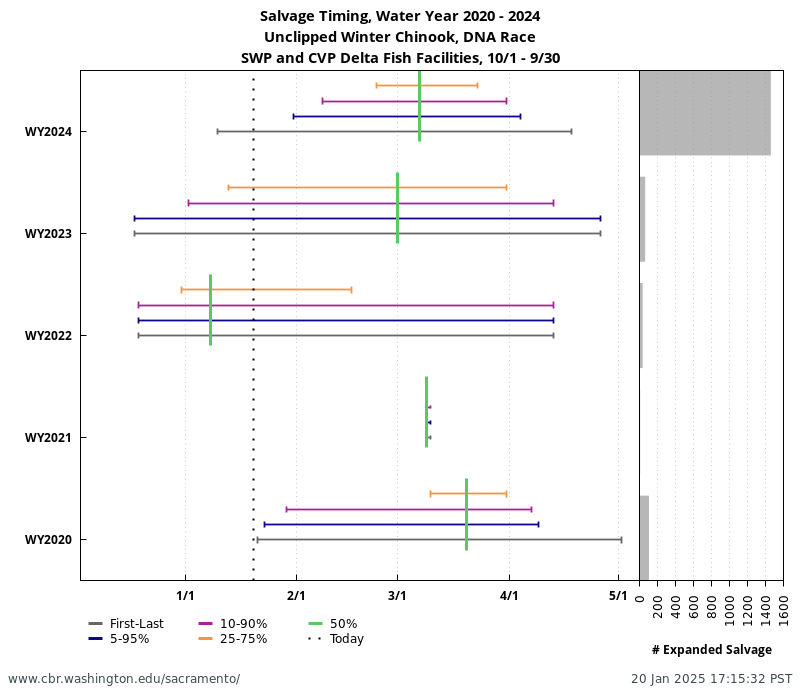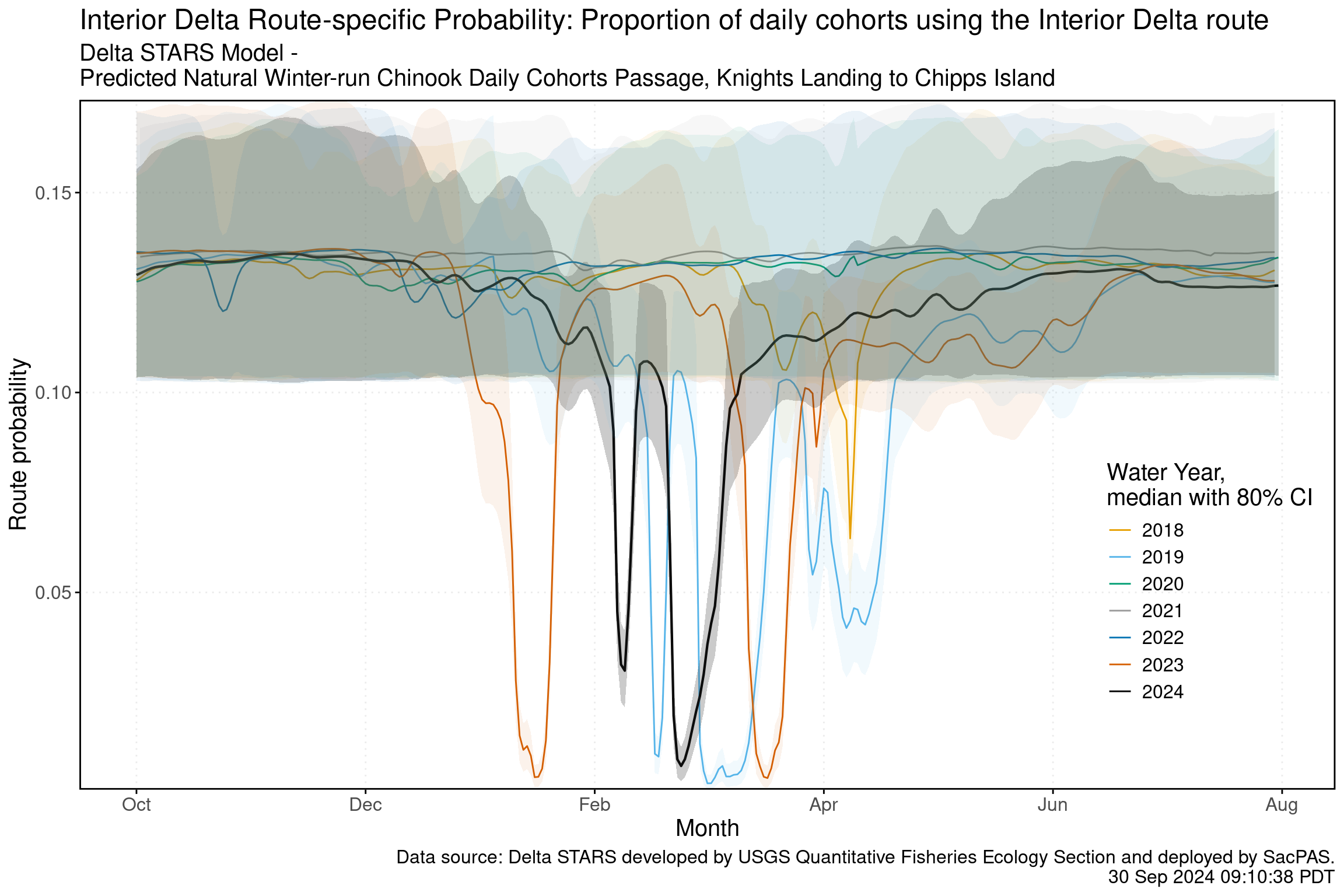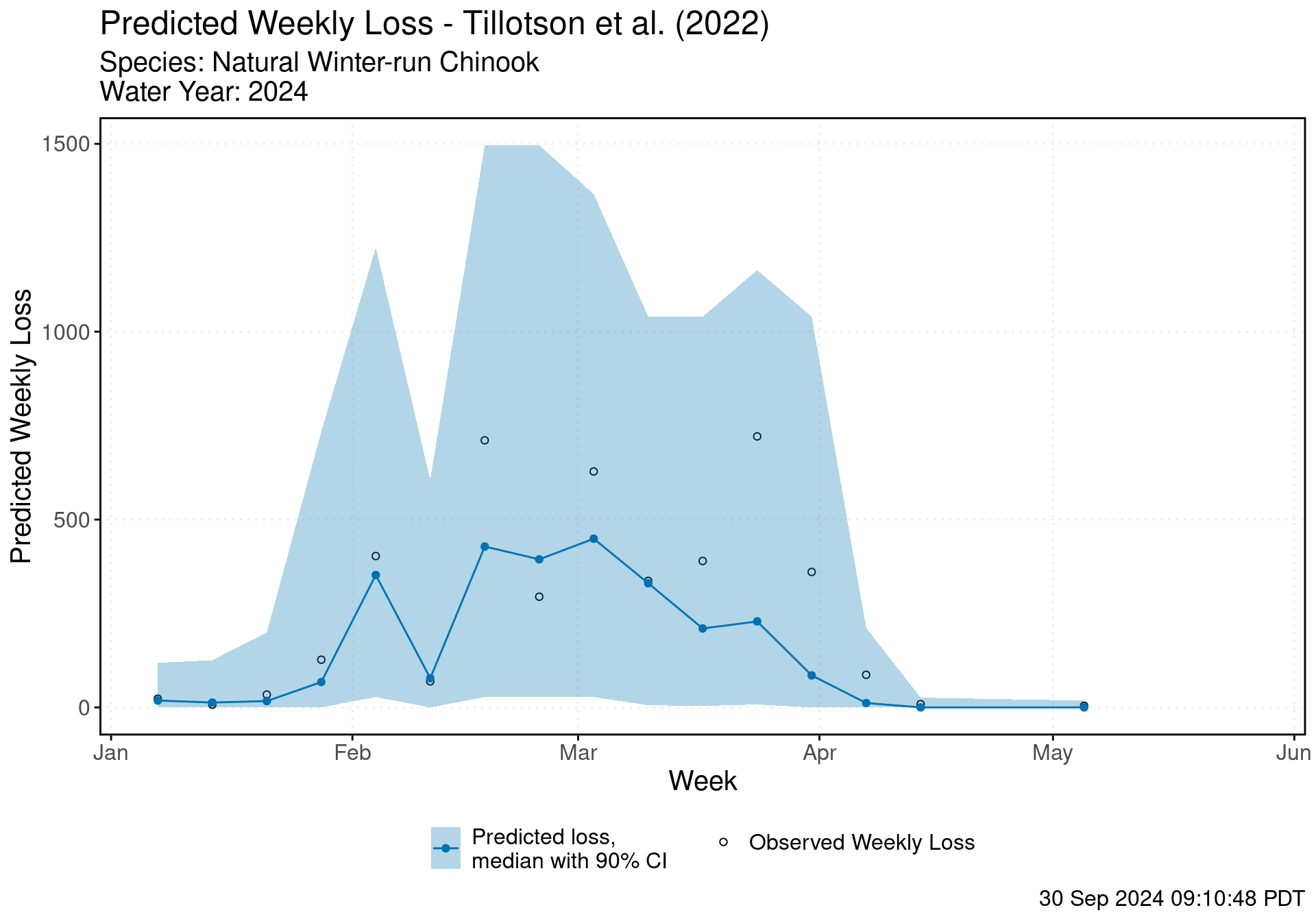Winter Chinook:
Juveniles in River
Migration Timing — annual data


Today Percent
| Species | Red Bluff Diversion Dam | Tisdale RST | Knights Landing RST | Sac Trawl (Sherwood) Catch Index | Chipps Island Trawl Catch Index | Salvage |
|---|---|---|---|---|---|---|
| Chinook, LAD Winter-run, Unclipped | 96.5% (94.6%,98.4%) BY: 2014 - 2024 |
65.4% (48.9%,81.9%) BY: 2014 - 2024 |
62.1% (41.7%,82.4%) BY: 2014 - 2024 |
36.8% (12.1%,61.4%) BY: 2014 - 2024 |
2.0% (-0.8%,4.9%) BY: 2014 - 2024 |
5.2% (-0.6%,11.0%) WY: 2016 - 2025 |
Calculations generated by SacPAS Migration Timing and Conditions by Cohort and Salvage Timing. Data Courtesy of USFWS, Red Bluff; CDFW via StreamNet and CDEC; USFWS, Lodi.
Current Catch

Juveniles in Delta
Salvage Timing — annual data


Juvenile Production Estimate JPE — annual data

Delta STARS Survival and Routing Probabilities



Percent Loss of Juvenile Production Estimate (JPE)


Loss


Daily Loss and Export with OMR

Loss Single Year Thresholds


Predicted Weekly Loss

| WY week | Date | Median weekly predicted loss [lower CI, upper CI] | Observed Data | |||||
|---|---|---|---|---|---|---|---|---|
| Observed loss | OMR USGS tidally filtered (CFS) | Export, SWP & CVP (CFS) | Avg flow at Sacramento (CFS) | Avg flow at San Joaquin (CFS) | Avg water temperature at Mallard Island (°C) | |||
| 13 | 2024-12-24 | 3.5 [0.0, 97.1] | 0.0 | -2878.3 | 2359.7 | 41792.7 | 1337.8 | 10.6 |
| 12 | 2024-12-17 | 9.6 [0.0, 107.4] | 2.9 | -4908.6 | 4604.7 | 43255.7 | 1270.9 | 10.1 |
| 11 | 2024-12-10 | 0.0 [0.0, 106.3] | 0.0 | -10408.6 | 10346.9 | 20807.8 | 1323.4 | 10.5 |
| 10 | 2024-12-03 | 0.0 [0.0, 76.9] | 2.6 | -9435.7 | 10473.4 | 20458.6 | 1322.5 | 11.2 |
| 9 | 2024-11-26 | 17.7 [0.0, 218.6] | 0.0 | -9957.1 | 10357.0 | 44642.6 | 1360.2 | 11.6 |
| 8 | 2024-11-19 | 0.0 [0.0, 145.6] | 0.0 | -6882.9 | 7403.9 | 24193.1 | 1343.2 | 12.8 |
| 7 | 2024-11-12 | 0.0 [0.0, 3.0] | 0.0 | -5171.4 | 4559.1 | 8796.7 | 1347.6 | 14.1 |
| 6 | 2024-11-05 | 0.0 [0.0, 0.0] | 0.0 | -4895.7 | 5188.3 | 9053.9 | 1654.5 | 15.2 |
| 5 | 2024-10-29 | 0.0 [0.0, 3.9] | 0.0 | -5897.1 | 5831.7 | 8494.9 | 2252.5 | 16.7 |
| 4 | 2024-10-22 | 0.0 [0.0, 0.0] | 0.0 | -6314.3 | 6290.6 | 8970.7 | 2177.5 | 18.1 |
| 3 | 2024-10-15 | 0.0 [0.0, 0.0] | 0.0 | -6250.0 | 5441.9 | 9392.1 | 2005.5 | 19.3 |
| 2 | 2024-10-08 | 0.0 [0.0, 0.0] | 0.0 | -8362.9 | 8238.1 | 12356.0 | 1562.6 | 20.7 |
| 1 | 2024-10-01 | 0.0 [0.0, 0.0] | 0.0 | -10024.3 | 9727.0 | 15992.7 | 1263.0 | 20.8 |
Adults in Ocean
CWT Smolt-to-Adult — annual data

PFMC Abundance, Harvest, Impact — annual data
| Year a/ | 3-Year Geometric Mean b/ | Abundance Forecast c/ | Postseason Abundance d/ | Postseason Abundance Value Footnote | Age-3 impact rate south of Point Arena, CA | |||
|---|---|---|---|---|---|---|---|---|
| Maximum Allowable (%) e/ | Preseason Forecast (%) | Postseason Estimate (%) | Postseason Estimate Value Footnote | |||||
| 2000 | 21.4 | |||||||
| 2001 | 8508 | 23.3 | ||||||
| 2002 | 9092 | 21.8 | ||||||
| 2003 | 5976 | 10.3 | ||||||
| 2004 | 18090 | 24.8 | ||||||
| 2005 | 18907 | 17.2 | ||||||
| 2006 | 2619 | 15.1 | ||||||
| 2007 | 2954 | 17.8 | ||||||
| 2008 | 4152 | 0.0 | ||||||
| 2009 | 1439 | 0.0 | ||||||
| 2010 | 696 | e/ | ||||||
| 2011 | 3263 | 28.3 | ||||||
| 2012 | 1797 | 5960 | 13.7 | 13.7 | 12.6 | |||
| 2013 | 1521 | 3067 | 12.9 | 12.9 | 18.8 | |||
| 2014 | 2380 | 3718 | 15.4 | 15.4 | 15.8 | |||
| 2015 | 3659 | 867 | 19.0 | 17.5 | e/ | |||
| 2016 | 3981 | 508 | 19.9 | 12.8 | 10.7 | |||
| 2017 | 2521 | 2117 | 15.8 | 12.2 | 17.6 | |||
| 2018 | 1594 | 8139 | 14.4 | 8.5 | 13.9 | |||
| 2019 | 1924 | 6935 | 15.7 | 14.8 | 10.0 | |||
| 2020 | 3077 | 10854 | 20.0 | 16.2 | 12.6 | |||
| 2021 | 9063 | 6346 | 20.0 | 14.7 | 18.8 | |||
| 2022 | 5971 | 3071 | 20.0 | 15.2 | 26.2 | g/ | ||
| 2023 | 4540 | f/ | 20.0 | 0.0 | NA | h/ | ||
| 2024 | 1013 | f/ | 12.1 | NA | NA | |||
| 2025 | 4507 | f/ | 20.0 | NA | NA | |||
- Table II-2 Footnotes
- a/ Year indicates the management year in which age-3 SRWC are exposed to ocean fisheries.
- b/ Allowable impact rates from 2012-2017 were determined by an abundance-based control rule, where abundance was defined as the most recent three-year geometric mean of escapement.
- c/ Since 2018 the abundance forecast has been defined as the predicted age-3 escapement in the absence of fisheries. Forecasts were made using a life cycle model through 2023. Beginning in 2024, forecasts were made using a Gaussian Process model.
- d/ Postseason estimates of the age-3 escapement in the absence of fisheries.
- e/ Beginning in 2018, allowable impact rates were determined by a new control rule utilizing forecasts of the age-3 escapement in the absence of fisheries.
- f/ Insufficient data for postseason estimate.
- g/ Preliminary. Incomplete cohort data (age-4 escapement unavailable).
- h/ Not estimated. Incomplete cohort data (age-3 and age-4 escapement unavailable).
Data extracted by SacPAS from:
PFMC (Pacific Fishery Management Council). 2024a. Preseason Report I: Stock Abundance Analysis and Environmental Assessment Part 1 for 2024 Ocean Salmon Fishery Regulations. (Document prepared for the Council and its advisory entities.) Pacific Fishery Management Council, 7700 NE Ambassador Place, Suite 101, Portland, Oregon 97220-1384.
Available from: https://www.pcouncil.org/salmon-management-documents/
Adults in River
Adult Escapement — annual data




